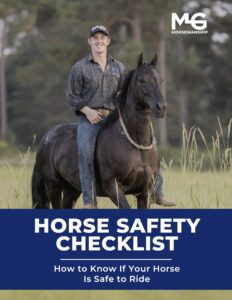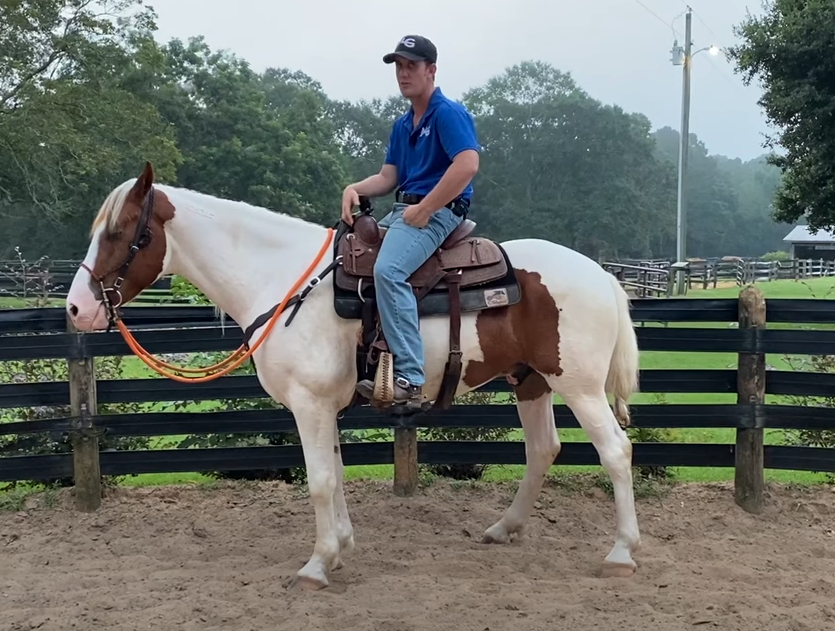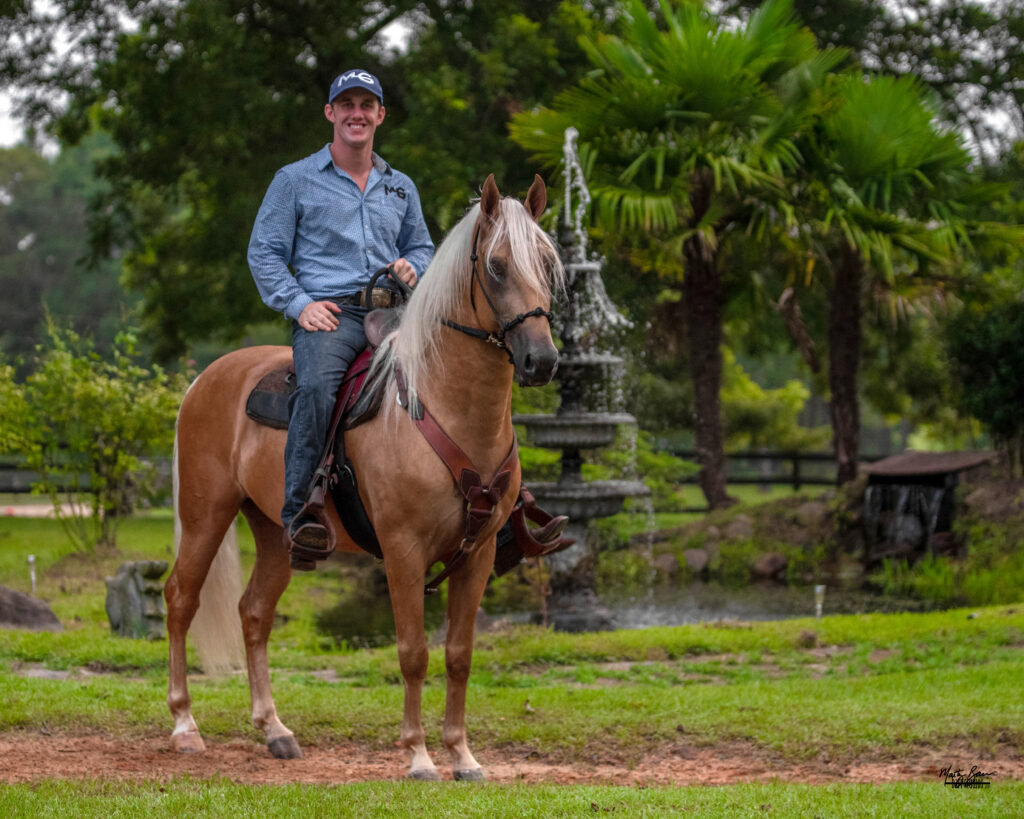Today we are talking about loose rein vs. contact rein when you are riding your horse.
Watch The Video Here Or Continue Reading Below!
What’s going on guys we’re back again with a much-requested video. The difference between loose rein and contact rein. The pros and the cons, why and why nots of rein contact. Whenever I think about the two most trained horses in the whole horse industry, the two sports that come to mind are reining and dressage. Dressage is 4-500 years old and reining being a lot newer, around 50-70 years old.
Differences of Loose vs. Contact Reins
The big difference I notice is, it’s the exact same sport, it’s just we’re wearing different clothes and we’re looking for a little bit different stuff. Show me how broke your horse is, show me what control you have of them and how little of cueing can be seen. The big difference that I see is in dressage, for a horse to be finished, it takes years and years for them to get there. For a reiner, at three years old, they have futurity horses that are finished have flying lead changes, spin slides, and all the bells and whistles. Do I think it’s because American Quarter horses are just so much smarter than Warm Bloods and Andalusians? Absolutely not! Do I think the reiners are just that much better horsemen than the dressage riders? No! I think we’re all in the same boat.
The big difference that I see because I come from gaited horses is the contact on the reins. I ride these horses english, very dressage style on a contact rein. Whenever I’m on a gaited horse, a dressage horse, or an english style horse my communication is this: bad horse is a tight hold on the reins, good horse is a fraction of a release on the reins, allowing for a looser rein but still keeping contact. Everything happens right here inside my hands because we’re on a contact rein. We are on a rein that he is feeling the whole time.
Rewarding The Horse on Loose vs. Contact Reins
The margin of error is very small and the reward for doing right is very small. Versus whenever I ride him around western like a reiner, when he is doing the right thing: here you go here’s all the reins. When he’s a “bad horse” I take the reins in until I have some contact on his mouth. Very quickly it becomes so apparent, so early, so quickly, that on that loose rein: “Oh, I’m doing the right thing.”
The pros to being on a loose rein is the horse is going to understand very clearly, very quickly, how to do the right thing. He learns what’s right, what’s wrong, and what the repercussions are. The other thing is whenever they are on a loose rein you feel like they’re not surging forward. You feel like you can do everything, slow them down, back them up. Get them to do what you want without having to touch their face. It tends well for a lot of things being handy and being able to go bridleless. There’s a lot more reining horses that are bridleless than dressage horses. This is because the english style dressage and gaited horse are depending on the contact. With that being said all my national championships and all my upbringing was with contact on the rein.
The Differences in Rein Contact With Western and English Horses
Even though that’s how I was raised, now I start horses completely different. When I was a kid from the very beginning my father would work the horse on the line very dressage style. I would sit up there and basically be the passenger as he was working the horse. I would have a contact rein and get that horse comfortable to driving. Now we colt start a horse then we do reining with a horse for two-four weeks while we’re getting control of their body, then go to a walk, trot, canter on a loose rein.
Yes, even the Paso Finos walk, trot, and canter on a loose rein. When we really get them relaxed and have control of their body, is when we start putting them back together. Gathering up the reins, by this point they know how to give to the pressure, and they know what we’re asking. They know how to control their body and we’re able to put them back on a contact rein. I also use a contact rein for neck reining.
It looks the same as if I am riding a western horse. I’ll start drawing right down to his withers and driving him forward with my legs. What this is going to do is it’s really going to help get my horse collected. It will get his butt and face closer together and get his legs under him. If I trot him off, I am going to give him a ‘good boy’ and release the pressure. One hand stays on his withers and that is going to allow me to keep pressure down low because I do not want to pick up his head.
It’s All About the Communication
I want him to be able to accept the contact but then I’m going to let him go for being a good boy. That’s how I would use the contact rein on a western horse. On my english horses or my gaited horses, I’m going to drive that horse into a rein and that’s how I’m going to go compete. The difference and the pro for the contact rein is you can communicate so quietly when showing. Whenever you are showing on a loose rein you must have all that communication through your legs and be subtle with your spurs, legs, and feet. You are not communicating through your reins when they are loose.
When I am communicating with my gaited horses in the show ring everything happens right here inside my hands. I can tell them to pick a shoulder up or to not look outwards. I can do anything like speed up, slow down, good boy, bad boy, all those things happen on that contact rein. I’ll be going around the ring for an hour in the show ring and all my conversation happens right inside this tight contact on the reins. The pros of the contact rein are that we can have subtle communication in our hands.
In Conclusion about REIN CONTACT
The pros of the long rein, or western rein, is we really get a horse where they don’t try to build up and they get a lot handier because they are guiding off of your legs and seat. Versus relying on your hands, this is going to give you a lot more relaxed look. I’m using a loose rein for anything western, anything that I want handy: obstacles, trail riding, anything like that. I’m using my contact rein for any horse that I want to build up.
If I’m trying to make a dressage or gaited horse. If I want to drive that horse up into the bridle, make them big, make them bold. I’m going to have them right there in my hands. Those are the pros and cons of contact versus loose reins. I hope that helps you and I hope that answers some of the questions that you all have had. I’ll see you in the next video!
That’s how we ride with a loose or contact rein! Thank you guys so much for reading, join me next week for the next topic!
Check out more free training resources HERE!
HOW SAFE IS YOUR HORSE?
Can you control every part of his body, even if he’s scared or unsure?
There are some specific things that I believe every horse should be able to do before he or she is considered completely safe to ride. So that you can see how safe your horse is to ride, I’ve created this FREE Horse Safety Checklist.





